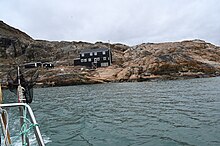
Summary
65°41′N 37°55′W / 65.683°N 37.917°W


Sermilik Station is a glaciology research station on Ammassalik Island, dedicated to the research of the nearby Mittivakkat Glacier. It is run jointly by the Department of Geography and Spatial Planning at the University of Graz and the Department of Geography at the University of Copenhagen.
Location edit
The station is located on the west coast of Ammassalik Ø in East Greenland on the southern shore of Sivinganiip Kangertiva Bay, to the east of Sermilik Fjord.[1] The nearest inhabited places are Tasiilaq 15 km southeast and Tiilerilaaq 23 km north. Deserted Ikkatteq is only 6 km to the south. Directly east of the station is the Mittivakkat glacier.
History edit
In 1933, the glaciers of Ammassalik Ø were first subjected to a scientific survey by Knud Rasmussen's Seventh Thule Expedition. In the International Geophysical Year 1957, the Mittivakkat glacier was one of the Danish research objects. At that time it had retreated by 600 m compared to 1933. In 1970 The station was built by the University of Copenhagen to provide the logistical base for the research.[2] In 1972, an avalanche destroyed the main building. It was rebuilt later closer to the shore, which is its current location.[3]
In 2022, the University of Graz signed a cooperation agreement with the University of Copenhagen and, with a donation from Austrian entrepreneur Christian Palmers,[4] built another two-story building that will provide space for 25 researchers from 2024.[5] The Station will be run jointly by both universities.
Equipment edit
The station consists of three buildings operated by the University of Copenhagen and the main house for which the University of Graz is responsible.
The University of Copenhagen buildings consist of a 60 m² wooden house with three living rooms, a dining room, a lounge, a kitchen, a toilet, and a pantry. In addition, there is a second, non-insulated building of 50 m², which contains a workshop, a storage room with a dinghy, and accommodation for four people. A third building stores the fuel and other equipment.
The two-story house of the University of Graz offers space for 25 people in summer. Common rooms are located on the first floor, sleeping rooms on the upper floor. The building is designed so that it can be used by up to six people even in winter, although the upper floor is then largely closed off for energy efficiency reasons. Electricity will be supplied by photovoltaics and battery. There is also a diesel generator as a backup and for a few weeks in January. Fresh water comes from a nearby spring and from the outflow of the Mittivakkat glacier. Seawater is used for flushing toilets.[6]
Science edit
A year-round monitoring program of basic climate data and the local climate gradient in the drainage basin of the Mittivakkat glacier is carried out at the station. The main focus is on the mass balance of the glacier, sediment transport and landscape-forming processes. Based on the data series obtained since the early 1990s, models have been developed that can be used to forecast the effects of climate change on the development of the glaciers.[7][8]
Researchers from the University of Graz are also investigating here what consequences climate change has on the occurrence of the storm wind Piteraq, which repeatedly causes devastating damage to buildings in East Greenland.[9]
See also edit
References edit
- ^ "Austrian Sermilik Research Station by University of Graz · M3JM+9X4, Íkáteq, Greenland". Austrian Sermilik Research Station by University of Graz · M3JM+9X4, Íkáteq, Greenland. Retrieved 2023-09-21.
- ^ IGN (2013-11-18). "History and facilities". ign.ku.dk. Retrieved 2023-09-21.
- ^ Ruhsam, Christoph (2023-08-10). "The History of Sermilik Station". APRI. Retrieved 2023-09-21.
- ^ andreas.puschautz (2023-09-15). "Warum Herr Palmers der Uni Graz eine Polarstation finanziert hat". kurier.at (in German). Retrieved 2023-09-21.
- ^ "Sermilik Research Station - Sermilik-Forschungsstation in Grönland". sermilik-station.uni-graz.at. Retrieved 2023-09-21.
- ^ Ruhsam, Christoph (2023-09-15). "Pre-opening of the Austrian Polar Research Station "Sermilik"". APRI. Retrieved 2023-09-21.
- ^ "Sermilik Research Station". INTERACT. Retrieved 2023-09-21.
- ^ Ernstsen, Verner Brandbyge (2013-11-15). "The Sermilik Scientific Research Station". ign.ku.dk. Retrieved 2023-09-21.
- ^ "Riesenschritt für Polarforschung: Graz ist ab sofort in Grönland dem Klimawandel auf der Spur". www.kleinezeitung.at (in German). 2023-09-14. Retrieved 2023-09-21.
- Hasholt, Bent (2008), 75 years of research at the Sermilik Station 1933-2008, Danish Journal of Geography
- Danish Polar Center for Researchers, DPC, archived from the original on June 11, 2008, retrieved June 7, 2008


